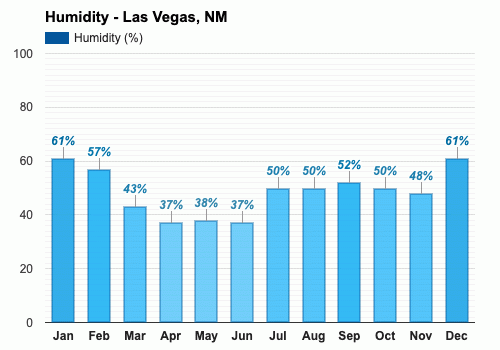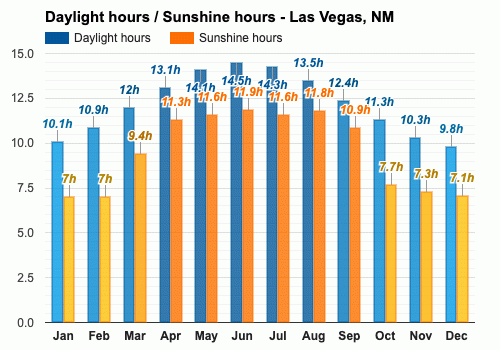Contents
- The climate of Las Vegas
- The best time to visit Las Vegas
- The worst time to visit Las Vegas
- Spring weather in Las Vegas
- Summer weather in Las Vegas
- Autumn weather in Las Vegas
- Winter weather in Las Vegas
- Weather in January
- Weather in February
- Weather in March
- Weather in April
- Weather in May
- Weather in June
- Weather in July
- Weather in August
- Weather in September
- Weather in October
- Weather in November
- Weather in December
- Frequently asked questions
- Average temperature
- Average pressure
- Average wind speed
- Average humidity
- Average rainfall
- Average rainfall days
- Average snowfall
- Average snowfall days
- Average daylight
- Average sunshine
- Average sunshine days
- Average UV index
- Average cloud cover
- Average visibility
Climate and monthly weather forecast
The climate of Las Vegas
Las Vegas climate remains moderately humid throughout the year, with relative humidity percentages in the vicinity of 37% to 61%. Tellingly, rainfall does not follow a strict seasonal pattern. The span of the year sees a varied rainfall from 0.47" (12mm) to 1.65" (42mm), with the much pronounced during the summer months. Snowfall is characteristic of winter with the maximum of 5.04" (128mm) observed predominantly in January, and typically drops off after February.
Unique in its own way, Las Vegas experiences longer daylight hours of up to 14.5 hours during the summer, giving more than enough sunlight for outdoor activities. This light becomes less generous in the winter, shrinking to a mere 9.8 hours per day. Delightfully, average sunshine hours are usually high, oscillating from about 7 hours in the winter months to 11.9 hours at the height of summer.
The best time to visit Las Vegas
The worst time to visit Las Vegas
Spring weather in Las Vegas
Summer weather in Las Vegas
Autumn weather in Las Vegas
Winter weather in Las Vegas
Weather in January
Weather in February
Weather in March
Weather in April
Weather in May
Weather in June
Weather in July
Weather in August
Weather in September
Weather in October
Weather in November
Weather in December
Published by: Weather U.S. | About Us
Data Sources | Weather Forecasting & Climate
Frequently asked questions
What are the most humid months in Las Vegas?
How much does it rain in Las Vegas?
When does it snow in Las Vegas?
What is the snowiest month in Las Vegas?
How many days does it snow in Las Vegas?
What are the months with the least sunshine in Las Vegas?
What is the month with the lowest UV index in Las Vegas?
When is Daylight Saving Time (DST) in Las Vegas?
What are the least humid months in Las Vegas?
When it does not snow in Las Vegas?
When are the longest days in Las Vegas?
What month has the most sunshine in Las Vegas?
What is the month with the highest UV index in Las Vegas?
What month is the hottest in Las Vegas?
What is the rainiest month in Las Vegas?
What is the driest month in Las Vegas?
What month is the coldest in Las Vegas?
What is the month with the shortest days in Las Vegas?

Average temperature
Las Vegas, NM
The warmest month (with the highest average high temperature) is July (81.5°F).
The month with the lowest average high temperature is December (42.1°F).
The month with the highest average low temperature is July (59.5°F).
The coldest month (with the lowest average low temperature) is December (23.9°F).

Average pressure
Las Vegas, NM
- Average pressure in January:
30.13"Hg - Average pressure in February:
30.04"Hg - Average pressure in March:
29.97"Hg - Average pressure in April:
29.87"Hg - Average pressure in May:
29.88"Hg - Average pressure in June:
29.89"Hg
- Average pressure in July:
29.98"Hg - Average pressure in August:
29.99"Hg - Average pressure in September:
30"Hg - Average pressure in October:
30.01"Hg - Average pressure in November:
30.07"Hg - Average pressure in December:
30.09"Hg
The month with the highest atmospheric pressure is January (30.13"Hg).
The month with the lowest atmospheric pressure is April (29.87"Hg).

Average wind speed
Las Vegas, NM
- Average wind speed in January:
9.1mph - Average wind speed in February:
9.9mph - Average wind speed in March:
10.8mph - Average wind speed in April:
10.9mph - Average wind speed in May:
10.6mph - Average wind speed in June:
9.5mph
- Average wind speed in July:
7.3mph - Average wind speed in August:
7.1mph - Average wind speed in September:
7.8mph - Average wind speed in October:
8.9mph - Average wind speed in November:
9.6mph - Average wind speed in December:
9.5mph
The windiest month (with the highest average wind speed) is April (10.9mph).
The calmest month (with the lowest average wind speed) is August (7.1mph).

Average humidity
Las Vegas, NM
The months with the highest relative humidity are January and December (61%).
The months with the lowest relative humidity are April and June (37%).

Average rainfall
Las Vegas, NM
- Average rainfall in January:
0.63" - Average rainfall in February:
0.55" - Average rainfall in March:
0.71" - Average rainfall in April:
0.55" - Average rainfall in May:
0.63" - Average rainfall in June:
0.71"
- Average rainfall in July:
1.65" - Average rainfall in August:
0.94" - Average rainfall in September:
0.87" - Average rainfall in October:
0.83" - Average rainfall in November:
0.47" - Average rainfall in December:
0.63"
The wettest month (with the highest rainfall) is July (1.65").
The driest month (with the least rainfall) is November (0.47").

Average rainfall days
Las Vegas, NM
- Average rainfall days in January:
3.4 days - Average rainfall days in February:
3.8 days - Average rainfall days in March:
5.5 days - Average rainfall days in April:
7.3 days - Average rainfall days in May:
6.5 days - Average rainfall days in June:
7.3 days
- Average rainfall days in July:
11.5 days - Average rainfall days in August:
9.8 days - Average rainfall days in September:
8 days - Average rainfall days in October:
6.1 days - Average rainfall days in November:
2.6 days - Average rainfall days in December:
4.3 days
The month with the highest number of rainy days is July (11.5 days).
The month with the least rainy days is November (2.6 days).

Average snowfall
Las Vegas, NM
- Average snowfall in January:
5.04" - Average snowfall in February:
3.94" - Average snowfall in March:
2.68" - Average snowfall in April:
1.1" - Average snowfall in May:
0.63" - Average snowfall in June:
0"
The month with the highest snowfall is January (5.04").
The months with the least snowfall are June, July, August and September (0").

Average snowfall days
Las Vegas, NM
- Average snowfall days in January:
7.1 days - Average snowfall days in February:
7.1 days - Average snowfall days in March:
4.6 days - Average snowfall days in April:
2.3 days - Average snowfall days in May:
0.6 days - Average snowfall days in June:
0 days
- Average snowfall days in July:
0 days - Average snowfall days in August:
0 days - Average snowfall days in September:
0 days - Average snowfall days in October:
1.8 days - Average snowfall days in November:
3.2 days - Average snowfall days in December:
7.9 days
The month with the highest number of snowfall days is December (7.9 days).
The months with the least snowfall days are June, July, August and September (0 days).

Average daylight / Average sunshine
Las Vegas, NM
- Average daylight in January:
10h and 1min - Average daylight in February:
10h and 5min - Average daylight in March:
12h and 0min - Average daylight in April:
13h and 1min - Average daylight in May:
14h and 1min - Average daylight in June:
14h and 3min
- Average daylight in July:
14h and 2min - Average daylight in August:
13h and 3min - Average daylight in September:
12h and 2min - Average daylight in October:
11h and 2min - Average daylight in November:
10h and 2min - Average daylight in December:
9h and 5min
The month with the longest days is June (Average daylight: 14h and 30min).
The month with the shortest days is December (Average daylight: 9h and 48min).
- Average sunshine in January:
7h and 0min - Average sunshine in February:
7h and 0min - Average sunshine in March:
9h and 2min - Average sunshine in April:
11h and 2min - Average sunshine in May:
11h and 4min - Average sunshine in June:
11h and 5min
- Average sunshine in July:
11h and 4min - Average sunshine in August:
11h and 5min - Average sunshine in September:
10h and 5min - Average sunshine in October:
7h and 4min - Average sunshine in November:
7h and 2min - Average sunshine in December:
7h and 1min
The month with the most sunshine is June (Average sunshine: 11h and 54min).
The months with the least sunshine are January and February (Average sunshine: 7h and 0min).

Average sunshine days
Las Vegas, NM
- Average sunshine days in January:
22.8 days - Average sunshine days in February:
19.4 days - Average sunshine days in March:
21.3 days - Average sunshine days in April:
19.3 days - Average sunshine days in May:
22.8 days - Average sunshine days in June:
21.6 days
- Average sunshine days in July:
17.3 days - Average sunshine days in August:
18.9 days - Average sunshine days in September:
19.4 days - Average sunshine days in October:
22.7 days - Average sunshine days in November:
24.6 days - Average sunshine days in December:
21.8 days
The month with the most sunshine days is November (24.6 days).
The month with the least sunshine days is July (17.3 days).

Average UV index
Las Vegas, NM
The month with the highest UV index is June (UV index 6).
The months with the lowest UV index are January, February, November and December (UV index 2).

Average cloud cover
Las Vegas, NM
The months with the most cloud cover are February, July and December (Cloud cover 20).
The month with the least cloud cover is June (Cloud cover 13).

Average visibility
Las Vegas, NM
The months with the highest visibility are January, February, March, April, May, June, July, August, September, October, November and December (6mi).
The months with the lowest visibility are January, February, March, April, May, June, July, August, September, October, November and December (6mi).